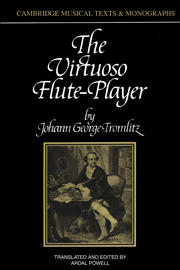Book contents
- Frontmatter
- Contents
- Translator's note
- Introduction by Eileen Hadidian
- Title in the series
- DETAILED AND THOROUGH TUTOR FOR PLAYING THE FLUTE
- Foreword
- Introduction
- 1 The flute and its character
- 2 Holding the flute, and the embouchure
- 3 Fingering
- 4 The notes and rests, their values and denominations, and the other musical signs
- 5 Time-signatures, and how the notes are divided and counted in them; the beat itself, or counting time according to an appointed tempo
- 6 Tone and pure intonation
- 7 Modern key-signatures
- 8 The articulation proper to this instrument, or the means of governing the wind suitably, as well in slow as in moderately quick movements; also called the single tongue
- 9 The technique for executing fast and very fast passages clearly and roundly; also, though improperly, called the ‘double tongue’
- 10 The ornaments
- 11 The trill
- 12 Fermatas and cadenzas
- 13 The taking of breath in flute-playing
- 14 The discretionary ornaments; or how to vary a simple melody according to the rules of harmony, and to use these variations in a good and suitable way appropriate to the material
- 15 Summary of the whole, together with a few remarks for pupils and masters
- Fingering-chart
- Select bibliography
- Index
2 - Holding the flute, and the embouchure
Published online by Cambridge University Press: 01 June 2011
- Frontmatter
- Contents
- Translator's note
- Introduction by Eileen Hadidian
- Title in the series
- DETAILED AND THOROUGH TUTOR FOR PLAYING THE FLUTE
- Foreword
- Introduction
- 1 The flute and its character
- 2 Holding the flute, and the embouchure
- 3 Fingering
- 4 The notes and rests, their values and denominations, and the other musical signs
- 5 Time-signatures, and how the notes are divided and counted in them; the beat itself, or counting time according to an appointed tempo
- 6 Tone and pure intonation
- 7 Modern key-signatures
- 8 The articulation proper to this instrument, or the means of governing the wind suitably, as well in slow as in moderately quick movements; also called the single tongue
- 9 The technique for executing fast and very fast passages clearly and roundly; also, though improperly, called the ‘double tongue’
- 10 The ornaments
- 11 The trill
- 12 Fermatas and cadenzas
- 13 The taking of breath in flute-playing
- 14 The discretionary ornaments; or how to vary a simple melody according to the rules of harmony, and to use these variations in a good and suitable way appropriate to the material
- 15 Summary of the whole, together with a few remarks for pupils and masters
- Fingering-chart
- Select bibliography
- Index
Summary
I do not think that these two subjects should be isolated from one another, since anyone who does not hold the flute correctly, and has a nervous and tense demeanour, will certainly produce an equally nervous and tense sound. A stiff posture and a nervous grip on the flute have an effect on playing as a whole: everything sounds forced and fearful; pay close attention and you will see. A relaxed and unconstrained bearing does not only facilitate playing, but the whole performance becomes freer, more fluent and more pleasing.
This fault can be avoided by preparing to play quite freely, without any anxiety and without constraint or stress, and by holding the flute in just the same way; that is: do not stand there twisted and crooked and hunched up, holding the flute as though to crush it to pieces; otherwise you will force the air out into the flute with precisely the same strength as you are using to grip the flute itself. Neither should you step up so miserably and pitifully that the audience will scarcely be moved to sympathise with such a poorspirited wretch. Sound and the impression it produces are here very closely bound together.
A good, free stance can best be acquired in the following way: stand up quite straight and relaxed, the feet rather close together, but the left one a little to the fore; hold the head well up, looking straight ahead.
- Type
- Chapter
- Information
- The Virtuoso Flute-Player , pp. 43 - 52Publisher: Cambridge University PressPrint publication year: 1991



